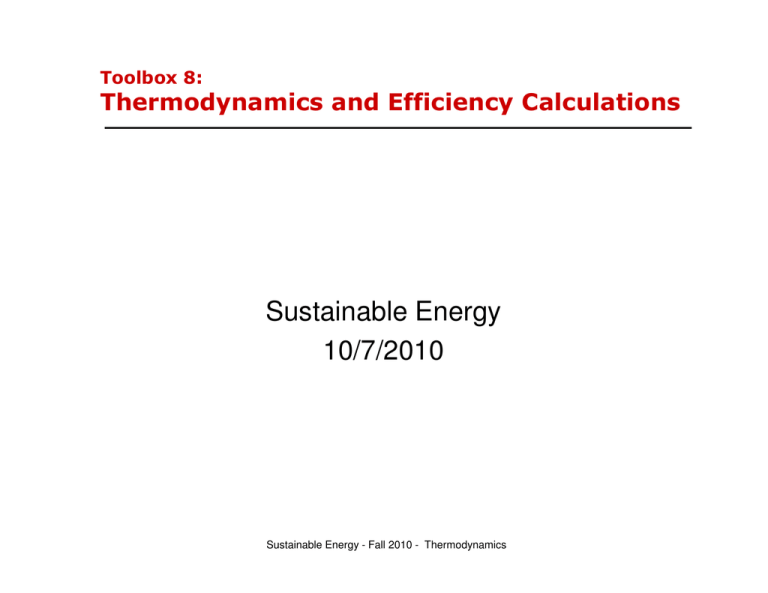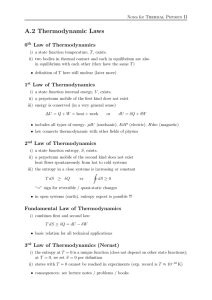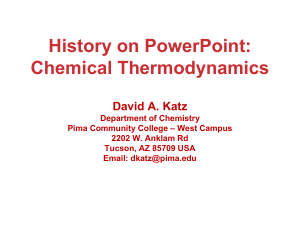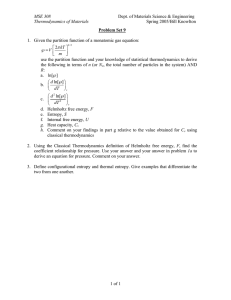Document 13444019
advertisement

Toolbox 8: Thermodynamics and Efficiency Calculations Sustainable Energy Energy 10/7/2010 Sustainable Energy - Fall 2010 - Thermodynamics First law: conservation of heat plus work • Heat (Q) and work (W) are forms of energy. • Energy can neither be created or destroyed. ∆E = Q + W • Applies to energy (J, BTU, kW-hr, …) or power (W, J/s, hp) • Work comes in several forms: – PdV, electrical, mgh, kinetic, … Photo by Ian Dunster on Wikimedia Commons. Conservation of Energy discovered in 1847 (Helmholtz, Joule, von Mayer) Energy, mass “balances”. “Control Volume” Conservation of energy: ΔE = Q + W + ∑ Ekin nkin − ∑ Ekout nkout k k Image removed due to copyright restrictions. Please see Fig. 4.6 in Tester, Jefferson W., and M. Modell. Thermodynamics and its Applications. 3rd ed. Englewood Cliffs, NJ: Prentice Hall, 1996. Chemical species conservation: Δnk = nkin − nkout + ∫∫ rk dV dt rk is chemical rate of formation of kth species reactions don’t change total mass or energy. Converting heat and work • In theory various forms of work can be interconverted with high efficiency (i.e. without making a lot of heat): – Kinetic, mgh, electricity – In practice it is difficult to efficiently convert some types of work: chemical/nuclear/light tend to make a lot of heat during conversions. • Work can easily be converted to heat with high efficiency: – Electrical resistance heaters, friction, exothermic reactions (e.g. combustion, nuclear reactions) • Impossible to convert Heat to Work with high efficiency: – Coal plants (~35%), nuclear plants (~35%), natural gas plants (~50%), automobiles (~20%) Entropy (S) and the second law of thermodynamics • Entropy: a measure of disorder • Entropy of the universe is always increasing ⎛ δQ ⎞ d S ≡ ⎜ ⎟ ⎝ T ⎠ rev Δ S universe ≥ 0 – Moves to more statistically probable state • Entropy is a state function 2nd Law discovered by Rudolf Clausius in 1865 Heat­to­work conversions Image removed due to copyright restrictions. Please see Fig. 14.7 in Tester, Jefferson W., and M. Modell. Thermodynamics and its Applications. 3rd ed. Englewood Cliffs, NJ: Prentice Hall, 1996. Heat­to­work conversions Qin Win Wout Qout A simple heat engine Energy balance: 0 (first law) 0 (steady state) Q& H 0 (first law) Accumulation = In − Out + Generation − Consumption 0 = Q& H −W& W& W& = Q& H Entropy balance: Sgen 0 (steady state) 0 (2nd (2nd llaw) aw) Accumulation = In − Out + Generation − Consumption Q& H & 0= + S gen TH S&gen Q& H =− <0 TH Violation of the 2nd Law! Not possible. Heat engine must reject heat, cannot convert all heat to work (since that would reduce entropy of the universe). A possible heat engine Energy balance: 0 (first law) 0 (steady state) Q& H 0 (first law) Accumulation = In − Out + Generation − Consumption 0 = Q& H − Q& C −W& W& W& = Q& H − Q& C Entropy balance: Sgen 0 (steady state) 0 (2nd (2nd llaw) aw) Accumulation = In − Out + Generation − Consumption Q& C Q& H Q& C & 0= − + S gen TH TC S&gen Q& C Q& H = − TC TH No obvious violation of the second law. Maximum efficiency of heat engine η heat →work Q& H W& ≡ & QH To maximize efficiency: W& Q& C η heat → work,max S&gen Q& C Q& H = − =0 TC TH TC & & QC = QH TH Algebra: W& ≡ Q& H TC & & Q − Q H H & & QH − QC TC TH = = = 1− Q& H Q& H TH Carnot efficiency η Carnot W&max TC ≡ = 1− Q& H TH • Sets upper limit on work produced from a process that has a hot and cold reservoir • Examples: coal power plant, gas power plant, nuclear • power plant, internal combustion engine, geothermal power plant, solar thermal power plant • Note: All temperatures must be expressed in Kelvin (or Rankine)! • Tc usually cannot be below environmental T. TH usually limited by materials (melting, softening, oxidizing) or by need to avoid burning N2 in air to pollutant NO. Free Energy and Exergy: Measures of How Much Chemical Energy is potentially available to do work • Usual measure of ability to do work: Free energy G = H – TS = U + PV - TS • We have some minimum temperature in our system (usually Tcooling, ~300 K), and a min pressure (e.g. Pmin = 1 atm) • Cannot reduce entropy, so Tcooling S and Pmin • m nV not available. • Call G-TcoolingS – PminV the “exergy”: how much chemical energy going in to a device is available to do work. • Should also consider the lowest-chemical-energy products (e.g. H2O and CO2), not ordinary standard states of enthalpy (H2, O2, graphite). • A ton of room temperature air has quite a lot of thermal energy, but none of that energy can be converted into work. Rankine cycle Image removed due to copyright restrictions. Please see Fig. 14.7 in Tester, Jefferson W., and M. Modell. Thermodynamics and its Applications. 3rd ed. Englewood Cliffs, NJ: Prentice Hall, 1996. Which of these Six Cases are not Feasible? Q Feasible Q Not Feasible. Violates Second Law Not Feasible. Violates Second Law Q W Hot Cold Q Feasible. Example: electric heater W Feasible. Heat Engine Q W Feasible. Heat Pump Q W Common heat­to­work engines in practice • Rankine cycle: (shown before) • Brayton cycle: combustion gases are directly expanded across a turbine and exhausted; “Combustion Turbine” CT g gas as p plants lants • Combined cycle (CC): Brayton cycle followed by a Rankine cycle on the turbine exhaust – IGCC: CC applied to syngas produced from coal • Internal combustion engine: combustion gases powering a piston In most Heat Engines, Work extracted as PdV • Boiling a liquid under pressure: big volume change, lots of W = ∫PdV • Turbines, pistons extract mechanical work from the pressurized gas by a nearly adiabatic expansion: γ γ γ −1 γ −1 P V P V = hi hi lo lo hi hi lo lo γ −1 ⎛ ⎛ VhighP ⎞ ⎞ nRThi γ = C p / C V ⎜1− ⎜ ⎟ W= ⎟ γ −1 ⎜ ⎝ VlowP ⎠ ⎟ ⎝ ⎠ TV =T V • Would like to arrange so that Plo~ 1 atm, Tlo ~ lowest feasible temperature – Low T good for Carnot efficiency – If we exhaust the gas, don’t want to waste enthalpy – T, P both drop in expansion, but at different rates Impractical to arrange ideal Phi, Thi • Material limits on pressure, temperature – Steam cycles confined to relatively low Thi • Internal Combustion Engines, Turbines – Exhaust tends to be too hot (T – (Tlo >> ambient) ambient) – A lot of energy carried away as waste heat in the exhaust (LHV, exergy analysis). So despite high Thi, these are usually much less efficient than Carnot. • Need to combine “Topping” and “Bottoming” cycles. Combined heat and power (CHP) Topping Heat and power are often produced together to maximize the use of otherwise wasted heat. • Topping cycles produce electricity from high T, and use the waste heat for other process needs (e.g., MIT co­ gen facility) • Bottoming cycles are processes which use medium heat T heat to generate electricity. Bottoming Q& H Q& H W&el Q&& C Lowtemp. heat need High- temp. heat need Q& M W&el Q& C Heat pumps • Move heat from cold to hot • Coefficient of performance (COP) Q& H Q& H TH COPw = ≤ W& TH − TC ~25°C Heat pump ~10°C Q& C • Practically, COPs are ~3 W& – 3x as much heat can be supplied as electricity supplied – Limited by power generation efficiency Select the More Efficient Home Heating Option • Burn NG with 90% efficiency furnace OR • Use electricity to drive heat pump – Heat pump COP is 3 – NG Power Plant Combined Cycle with 50% efficiency – Transmission and distribution losses are 10% Air conditioning and refrigeration • Type of heat pump • Coefficient of performance (COP) ~35°C Q& H Q& C Heat pump ~25°C W& Q& C TC ≤ COPs = & W TH − TC Can convert heat to chemical energy…but still run into Carnot limit • CH4 + 2 H2O + Q = CO2 + 4 H2 • ΔHrxn>0 and ΔSrxn>0 • Need to supply heat at high T (to shift equilibrium to the right) • Remove hot H2 from catalyst to “freeze” the equilibrium. • When we cool hot H2 to room T, emit heat at lower T (makes additional entropy). Conclusions 1. Heat plus work is conserved (from the First Law). 2. Heat can’t be converted to work with 100% efficiency (from the Second Law). 3. Real processes suffer from non-idealities which generally keep them from operating close to their thermodynamic limits (from real life, plus the Second Law).. Law) 4. Chemical, nuclear energy in principle are “work”, but most practical devices convert them into heat, then use heat engines to extract PdV work: Carnot limit 5. Careful accounting for energy/exergy and the limits on what is possible is necessary for assessing new energy proposals. Relatively easy to do, and the results are much more solid and exact than other aspects of the problem like financing, economics, marketing, politics. MIT OpenCourseWare http://ocw.mit.edu 22.081J / 2.650J / 10.291J / 1.818J / 2.65J / 10.391J / 11.371J / 22.811J / ESD.166J Introduction to Sustainable Energy Fall 2010 For information about citing these materials or our Terms of Use, visit: http://ocw.mit.edu/terms.







